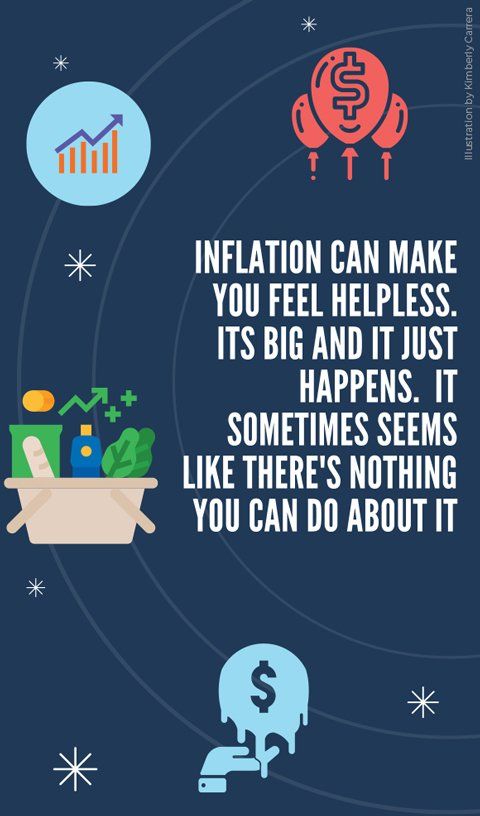Undress Your Car
When you get where you’re going, take the carrier off the top of the car. Studies have shown the aerodynamic drag of a car-top carrier reduced mileage by as much as 15%. Bike racks aren’t as bad, but they’re no help.
In inflationary times, it’s best to keep in mind Benjamin Franklin’s nearly forgotten adage: 'save your pennies and your dollars will save themselves.' While inflation is a pain, it’s also an opportunity to streamline your life in ways that will pay dividends for years to come. It can be an example of what economists call “the invisible hand” of the market, guiding those who are attentive in new and efficient directions.
Here are a few areas where a little thought and intentional action can make your budget and the world better.
Win the Gas Game
Everything that saves gasoline saves you money and improves the environment. You know the regular things: combine trips, don’t speed, keep your tires properly inflated, accelerate slowly and brake evenly. But the thinking driver can take other steps to reduce consumption and driving cost, particularly on long summer trips.
Fill Strategically
You wouldn’t depart without knowing the roads you’re going to take or the weather you may encounter; understand gas prices along your route, too. Gas costs different amounts in different markets. State gas taxes vary and regional use of anti-smog summer additives increases prices from five- to 15-cents a gallon. Waiting to fill-up until you’re running on empty is like playing the lottery: you’re taking the chance that you’ll have to stop someplace expensive. Instead, before traveling, put in a little web work at GasBuddy.com, which tracks prices across the country down to specific stations. Gassing-up on the right side of a state line or on the outskirts of a city can make a quarter-a-gallon difference.

Downgrade Your Gasoline
If your owner’s manual says premium gas is recommended, as opposed to required, experiment with regular instead. If your car still runs smoothly and your mileage stays consistent (a good indicator of general engine health), call the experiment a success and pocket the 60-cents a gallon you’re saving. Be more wary with small, turbocharged engines, but for most family cars, plain-old regular is just fine.
Drink Tap Water
It’s cheaper than bottled water, better for you than soft drinks, and doesn’t inject more single-use plastic into the environment. Get a water bottle and use it. If you cut out one sugary soft drink per day, that’s roughly $500 a year and 55,000 calories you’re saving.
Re-Examine Your Tech Trio
Phone, TV and data are complicated services camouflaged by jargon specifically created to confuse you. The natural reaction is to avoid dealing with them. Instead of avoidance, think of it as sport. Step up to the plate with the goal of saving $100 a month. Most people who haven’t freshened their contracts in a couple of years can do that, and sometimes more. Your needs change, and tech deals generally improve over time. You usually can’t get the new customer teaser rates, but you can almost always do better than you’re doing now. Do the same with your cable, streaming and internet service provider, which may not only save you money but should result in faster service, too. And when you’re done, you’ll feel like you slayed a dragon.
Keep Up On Maintenance
The tendency in tight times is to defer maintenance. Try not to do that. It’s a better risk-management strategy to spend small amounts now to avoid getting hit with surprise, back-breaking expenses at what will inevitably be the least convenient time possible. Your insurance policy against catastrophe is staying up-to-date on the small, joyless things that keep life running smoothly. Get your oil changed. Replace your furnace filters. Keep your medical appointments.
Cancel Subscriptions
We sign up for small, monthly charges and then forget they’re even there. Fortunes have been built on $3 a month debit card dings no one even notices anymore. US News and World Report estimates most households spend more than $3,000 a year on subscriptions, with a hefty percentage being no-longer-needed, dead budgetary weight. You can comb your bank statements yourself to find them, or you can search “subscription management app” online and choose a digital helper. There are a dozen reputable apps that call recurring charges to your attention and ask if you would like to cancel; for example, that $7.99 a month Pre-K learn/play program your college freshman hasn’t used in a decade. Most of the apps will then handle the actual cancellation for you. The apps cost a little more than one monthly subscription to a website that seemed important at the time, so if it unsubscribes you from two, you’re better off. And it will likely uncover far more than two subscriptions to cancel. Subscribe to one of the apps for a while and don’t forget to put a reminder in your calendar to unsubscribe after it has cleaned the parasites out of your checking account.
Schedule an Online Buying Day
Online shopping is fast, convenient and kind of mindless. We’ve all had packages arrive with little clear memory of having ordered them. To curb your impulses, set a rule that you can only shop online on certain days–and stick to it. (It’s amazing how many of these money-saving ideas should end with “… and stick to it.”) That will create a period during which your ardor for, say, that beautiful Icelandic wool sweater or new headcovers may cool, making it easier to resist temptation and leaving your bank account intact.
Defer Big Purchases
There’s a component of current inflation that is a hangover from COVID-19, and its disruption of manufacturing and supply chains. Experts say big-ticket items like home appliances, cars, computers and bicycles are likely to get cheaper in the next year. If you can, wait. It’ll help your cash flow now, and is a small gamble that could pay-off big savings when the economy returns to normal.